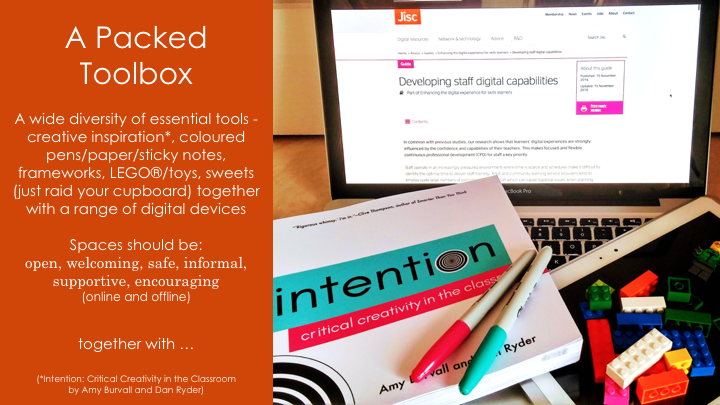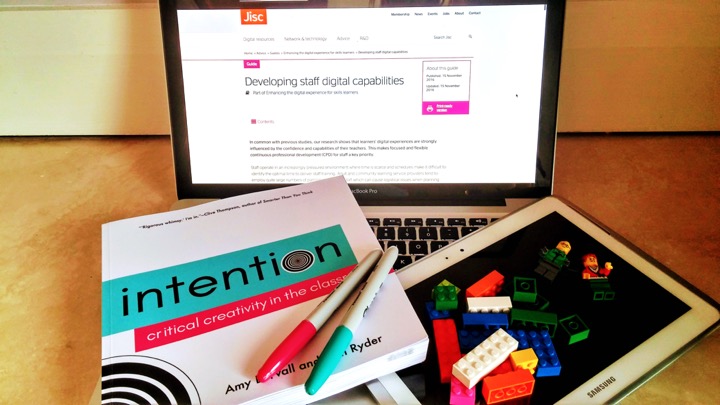Looking ahead to #OER19 in Galway and browsing the list of great sessions the one I knew for sure that I would be attending was Amaz-Zine: How to create a DIY OER Zine with Amy Burvall and Bryan Mathers as I have long been a fan of both of these creative geniuses.
I spotted Amy’s book with Dan Ryder, intention, critical creativity in the classroom, back in summer 2017 on Twitter and immediately ordered a copy. The book is crammed full of creative prompts and activities and whilst being targeted at school classrooms I could see that many had transferability to higher education, I just needed to figure out where and how. I did use it straightaway however, in a slide deck as one of the key elements in my toolbox as an educational technologist. I also designed this slide deck around the open work by Bryan (double fandom).

Whilst figuring out how to use the activities in the classroom I used a couple to respond to Daily Creates (#ds106) shown below. I also designed postcards for goody bags that I handed out after a LEGO® Serious Play® workshop about integrating creativity into the curriculum (LEGO activities feature in the book as well). I advocated the book and the Oreo Challenge activity on one card (side note – really need to work on this project for wider dissemination).
Book Stack Summary
I turned this one around to answer the prompt of Found Poem:
#ds106 #tdc2269 #IntentionStack pic.twitter.com/5FMVFSXemt
— Clare Thomson (@slowtech2000) March 27, 2018
Blackout Poetry
#ds106 #tdc2190 Control – my very first attempt at a black out poem pic.twitter.com/GA8i0drKyK
— Clare Thomson (@slowtech2000) January 18, 2018
After a year, I finally found just the right place. I facilitated a workshop for medical students embarking on a summer project in medical education, on moving their thinking from learner to teacher. I opted for a mash up between Oreo Challenge and Fauxial Media Profiles. I asked the students to create an aspirational social media account profile for their ideal educator. A lot of puzzled looks came my way, but I held my ground and didn’t give them any more detailed instructions, waiting for them to get stuck in. And get stuck in they did after a few moments thought. I think in this case the inclusion of the Haribos was the secret to its success as the bag of sweets contained ready-made metaphors for them.
2/2 An intention mashup of #IntentionFauxialMedia and #IntentionOreo with medical students and educators – depicting an ideal teacher #intentionthebook pic.twitter.com/kCtJuQQGa8
— Clare Thomson (@slowtech2000) June 26, 2018
The next chance I got was during the Wikipedia in Medicine module that I ran with Richard Fallis at Queen’s University. Firstly, in order to get discussions going around the concept of open education I used the Two Images, One Question task. In groups of two or three the students created a presentation or document with two images and one question regarding their ideas/experiences of open education. They sent these directly to the Microsoft Teams chat and we were immediately able to view them on screen as we discussed each group’s contribution in turn. The short creative task got them thinking about a new topic and also about how to search for Creative Commons images. It turned a dry seminar into an active workshop and they gained a whole new understanding of OER.
The second activity I used was the mash up of the between Oreo Challenge and Fauxial Media Profiles again. This time the slant was on their identities of being a Wikimedian. As before, I waited out the puzzled looks as I didn’t give really specific instructions and let them have a flounder, asking each other for advice and then beginning to get colour onto the page (Sharpies rock). What I wanted them to get from the task was a better sense of reflective practice. Each gave a wonderful story when feeding back about their profile rather than describing what it looked it. I used this session to discuss the differences between description and reflection. After reading their diaries however, what they got out of it was 1. the enjoyment and freedom of having fun doing something active and creative and 2. that they were taken aback by how individual each creation was – as medical students they are more used with consistency and uniformity.
My take aways from my experiences of the book so far:
- Take the risk but be very prepared for everyone in the room to experience initial uncomfortableness – don’t be tempted to jump in and try to direct things.
- Whilst taking a risk, know your boundaries, these classes had approximately a dozen students and were low stakes.
- Mash up the activities to best fit your situation.
- Enjoy the process and accept that it will probably go down a route that you didn’t even plan for.
- A tough audience can end with even better results as they bring a healthy dose of scepticism with them.
- Be open and share.
- Buy the book, USE the book.
Medical students! See? #rigorouswhimsy can help students of all varieties make magic happen; love this mashup of #intentionthebook pathways! #iste18 #criticalcreativity https://t.co/MsCLrq0Lt4
— Dan Ryder (@WickedDecent) June 28, 2018
The workshop was indeed Amaz-Zine; it involved Sharpies, glue, scissors and lots and lots of fun and laughter all of the very best ingredients. A top, top bonus was getting my Intention book signed by Amy – in pink, of course.
Thanks, thanks and thanks again.

Leave a Reply